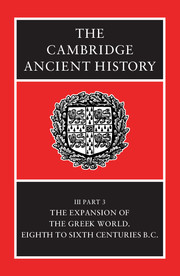Book contents
- Frontmatter
- Contents
- List of maps
- List of text-figures
- Preface
- 36a The Greeks in the Near East
- 36b The Greeks in Egypt
- 36c Cyprus
- 36d The Cypriot syllabary
- 37 The colonial expansion of Greece
- 38 The western Greeks
- 39a The eastern Greeks
- 39b Crete
- 39c Cretan Laws and Society
- 39d Euboea and the Islands
- 40 Illyris, Epirus and Macedonia
- 41 Central Greece and Thessaly
- 42 The Peloponnese
- 43 The growth of the Athenian state
- 44 The Tyranny of Pisistratus
- 45a Economic and social conditions in the Greek world
- 45b The material culture of Archaic Greece
- Chronological Table
- BIBLIOGRAPHY
- Index
- References
44 - The Tyranny of Pisistratus
Published online by Cambridge University Press: 28 March 2008
- Frontmatter
- Contents
- List of maps
- List of text-figures
- Preface
- 36a The Greeks in the Near East
- 36b The Greeks in Egypt
- 36c Cyprus
- 36d The Cypriot syllabary
- 37 The colonial expansion of Greece
- 38 The western Greeks
- 39a The eastern Greeks
- 39b Crete
- 39c Cretan Laws and Society
- 39d Euboea and the Islands
- 40 Illyris, Epirus and Macedonia
- 41 Central Greece and Thessaly
- 42 The Peloponnese
- 43 The growth of the Athenian state
- 44 The Tyranny of Pisistratus
- 45a Economic and social conditions in the Greek world
- 45b The material culture of Archaic Greece
- Chronological Table
- BIBLIOGRAPHY
- Index
- References
Summary
Solon to Pisistratus
Solon's reform broke the monopoly of office enjoyed till his time by the Attic nobility. This was bound to be resented, and the following years were punctured by strife over the appointment of the archon. The bleak record in Ath. Pol. 13.1–2 tells of two occasions when faction prevented an appointment, and then of Damasias who, though legitimately archon, held on to office for two years and two months till he was driven out by force. The first regular celebration of the Pythian games, in 582, is dated to the year of Damasias (Marm. Par. ep. 38; hyp. Pind. Pyth.): this must be his first and legal year, which is therefore 582/1, and this enables us to sort out Aristotle's indications of interval and so to date the two earlier years of anarchy to 590/89 and 586/5. We may doubt if anything certain was known beyond the fact that these two years were labelled anarchia in the official list, as for 404/3 when the succeeding democracy refused to recognize Pythodorus the archon of the Thirty. The case could have been similar here, not that Athens was literally without a chief magistrate in these years but that their successors did not recognize these elections as valid.
Damasias' usurpation was followed, acording to Ath. Pol. 13.2, by a decision, ‘ because of the faction, to appoint ten archons, five from the Eupatridae, three from the αγροικοι (agroikot), two from the δημιουργοι (demiourgoi), and these held office for the year after Damasias', that is presumably for the remaining ten months of 580/79.
- Type
- Chapter
- Information
- The Cambridge Ancient History , pp. 392 - 416Publisher: Cambridge University PressPrint publication year: 1982
References
- 11
- Cited by



